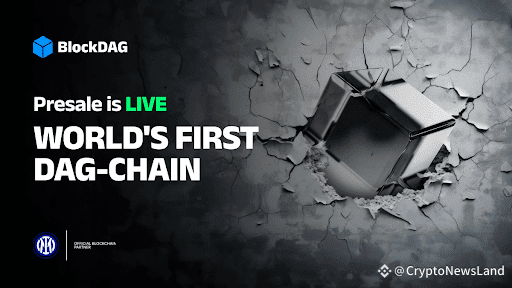
The challenge of achieving scalability, security, and decentralization together, often called the blockchain trilemma, has influenced crypto network design for more than ten years. Most blockchains manage to focus on two areas, but usually sacrifice the third. BlockDAG (BDAG) is trying a different strategy by joininga Directed Acyclic Graph (DAG) with a revised form of Proof-of-Work (PoW).
This combined method is made to handle thousands of transactions each second while keeping the trustless validation and decentralized nature of PoW systems like Bitcoin. With $360 million raised, over 2.5 million users, and more than 24.6 billion BDAG coins sold, BlockDAG’s model is getting attention from developers, miners, and crypto users. But does it really solve the trilemma? Let’s take a deeper look.
Using DAG for Speed: Fast, Ongoing Transaction Flow
The DAG setup lets transactions go through without being grouped into blocks. This is different from most blockchains that create blocks at set times and confirm them one by one. In DAG, each transaction links to others directly, which allows them to be confirmed in parallel.
BlockDAG’s DAG structure is built to handle between 2,000 and 15,000 transactions per second. That is much faster than Bitcoin, which handles around 7 TPS, or Ethereum, which does about 30 TPS.
Unlike systems that rely only on DAG, like IOTA or Nano, BlockDAG adds PoW validation to the structure. This choice helps keep the system fast but still avoids relying on any central authority or trusted nodes.
Using Proof-of-Work for Protection and Global Reach
BlockDAG uses a changed version of PoW to handle transaction order and stop fake identities. This setup spreads validation across a worldwide network of miners. Over 18,900 ASIC mining units have already been sold, and the X1 mobile mining app has more than 2.5 million users.
This PoW layer makes sure that validating a transaction requires real energy and is hard to fake. At the same time, the DAG helps speed up how quickly these transactions are confirmed.
BlockDAG is not picking speed over security. Instead, it uses DAG for faster flow and PoW for secure trust in one system.
In BlockDAG’s design:
Transactions are sent through the DAG first for fast confirmation among peers.
Miners then use PoW to check and confirm the transaction order.
This helps build a solid DAG and stops double-spending.
The network is already testing speeds of up to 10 blocks per second, which shows it can work both fast and reliably. This design lowers congestion and uses less energy than Bitcoin while still allowing open and non-custodial validation. The combined model also adds strength to finality and transaction accuracy, which are important when working with high transaction rates.
What Developers and Users Gain from This Model
Developers benefit from BlockDAG’s EVM support, as it allows smart contracts written in Solidity to run directly on the network. The DAG structure improves speed and reduces delays, making execution faster. A low-code builder is also available, helping users build and deploy contracts without needing deep coding skills.
Users can engage with the network through the X1 mobile miner or the upcoming Cold Wallet, which offer simple access to features like mining, staking, and trading. The Demo Exchange is live now, supporting real BDAG purchases and practice selling through demo tools.
With high-speed processing, trustless validation, and working tools ready before launch, BlockDAG is working to remove both technical and usage barriers in crypto adoption.
A Clear Step Toward Solving Blockchain Limits
BlockDAG’s use of both DAG and Proof-of-Work is a direct effort to meet scalability, security, and decentralization goals in one design. It avoids unproven solutions and instead builds on well-known models. The system mixes the strong security of PoW with the fast processing of DAG to create a balanced setup that may scale without losing trustless structure.
BlockDAG’s current presale price is $0.0016. When the coin lists, the confirmed price is $0.05. This points to a 3025% return from crypto presale to listing. If all coins go into circulation, the projected market cap could reach nearly $5 billion.
For anyone following the future of Layer 1 systems, BlockDAG offers a real example of how combining consensus models might guide the next phase of blockchain growth.
Presale: https://purchase.blockdag.network
Website: https://blockdag.network
Telegram: https://t.me/blockDAGnetworkOfficial
Discord: https://discord.gg/Q7BxghMVyu
Disclaimer and Risk Warning
This article is a sponsored press release and is for informational purposes only. Crypto News Land does not endorse or is responsible for any content, quality, products, advertising, products, accuracy or any other materials on this article. This content does not reflect the views of Crypto News Land, nor is it intended to be used for legal, tax, investment, or financial advice. Crypto News Land will not be held responsible for image copyright matters. Readers are advised to always do your own research before making any significant decisions.



